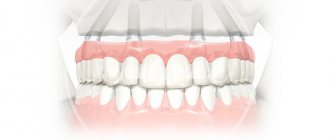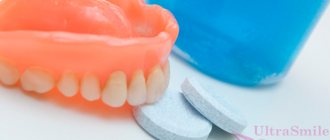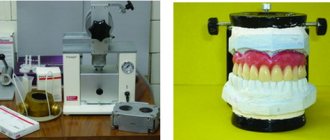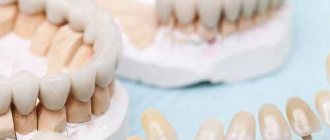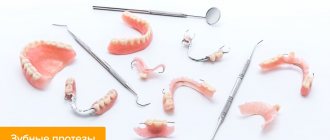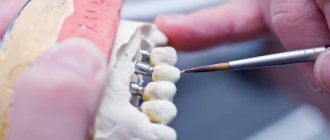Removable dental bridges and dentures are in great demand due to their affordable cost. Removable dentures are used for complete or partial loss of teeth, as well as as a temporary solution until a fixed structure is installed.
It should be noted that modern prosthetics are very different from the bulky and uncomfortable products of the last century. Now they look more aesthetically pleasing, have a natural appearance, fit tightly to the gums and are securely fixed.
Indications for removable prosthetics can also be inflammation of the gums, bone deficiency, or contraindications to the installation of dental implants.
Installation Features
Removable structures have a base that imitates natural gums. Therefore, they look natural, like natural teeth.
In case of complete edentia, the removable denture is attached directly to the gums. The prosthesis fits tightly to the soft tissues, without displacement or loosening.
The prosthesis is fixed using clasps, hooks or implants. The lower part is attached to the roots of the natural teeth, and the upper part is attached inside the base of the structure. If the prosthesis replaces the entire dentition, then fixation occurs only on the gums.
Clasp designs
Some of the most effective, comfortable and reliable are clasp dentures. They consist of a metal frame, a plastic base and artificial teeth. Among the advantageous differences of such structures is the distribution of load between the jaw bone and supporting dental units. Plastic plate dentures do not have this advantage, since when they are used, all the pressure falls mainly on the gum.
Methods of fastening clasp prosthetic systems:
- Metal hook-clasps. They are attached to the teeth adjacent to the defect.
- Locking connections, or attachments. Consist of two elements. One of them is attached to an artificial prosthesis, and the second is attached to an artificial crown that covers the supporting tooth.
- Telescopic crowns. This method of fixation increases the cost of the structure, so it is used less often.
Types of removable dentures
Dentures for complete absence of teeth
These removable dentures are a lightweight, curved plastic plate that covers the entire jaw and palate (if used on the upper jaw). Artificial teeth (made of plastic or porcelain) are attached to it. The removable bridge is fixed due to the natural suction effect of the gums. The use of removable structures is possible only in the case of complete edentia (loss of all teeth).
Conditionally removable orthopedic prostheses
Such removable dentures can be used in case of loss of single teeth (for example, chewing teeth) or in case of significant violations of the integrity of the dentition (loss of a group of teeth). These orthopedic elements can also act as temporary structures. To fix them on natural teeth, special locks (clasps) are used. The component is made of durable metal, which ensures its reliable installation.
It is important to understand that not all partial denture materials are suitable for restoring teeth in the smile area. Therefore, in the case of restoration of the front teeth, it is better to choose removable dentures on implants.
Lamellar
This type of plate dentures is most often used in cases of loss of chewing teeth. This is one of the simplest and most affordable removable dentures.
Removable sectors or segments.
They are unilateral partially removable dentures used when several chewing teeth are lost in a row on one side of the jaw.
Immediate dentures
This is a temporary structure. This product is designed to hold adjacent teeth in place and protect gums until a permanent denture or crown is fabricated. Externally, an immediate denture looks like an ordinary tooth, but on the sides it has special clippers in the form of wings, with the help of which it is secured to the gum. Thanks to these fastenings, it received its second name - “butterfly”
Modern materials
Removable acrylic dentures
Budget option based on polymers. Conventional plastic dentures strongly rub the gums and do not fit well. However, our laboratory specialists use a special formula - a new generation acrylic prosthesis, with the addition of crushed diamond chips. The design is more resistant to chewing loads, comfortable to wear and has an aesthetic appearance, and also provides a longer service life.
Elastic
These can be soft nylon or thin removable dentures made of acrylic resins (Acry Free). The material adheres tightly to the gum tissue in the oral cavity. Does not cause pain or discomfort. Can be used for bruxism.
Who is suitable for nylon prostheses?
The use of removable nylon dentures is acceptable in the absence of one or several teeth. The products are used in cases of lack of extreme, lateral or front teeth in a row and even in cases of complete edentia. Edentia is commonly understood as the absence of all teeth in a row or jaw. The use of removable dentures made of nylon is possible for sensitive and weak gums, as well as for restoring dentition in children. Such orthopedic products do not contain metal compounds and are excellent for patients with allergic reactions. As for nylon itself, it is absolutely hypoallergenic.
With locks (sandwich dentures)
Installation requires two healthy tooth roots. One part of the lock is attached to the dental bridge, the second (abutment) is fixed in the root of the tooth. The prosthesis does not have a septum in the palate, which ensures maximum taste sensitivity. Thanks to the partial overlap, the removable denture can be worn for several days, only being removed for cleaning.
Dentures on implants
The most popular type of prosthesis. It is securely attached to the gum due to four supports connected to each other by a beam. Removable dentures on implants provide an even load on the jawbone, and the absence of a palate in the structure guarantees a natural taste perception when eating. It is easy to use, has a long service life and can be easily replaced with a new one if necessary. The only drawback is the high cost of installation due to the materials used. However, the price is fully justified by the quality, comfort and durability of the product.
Clasp dentures
This type of prosthesis is suitable for complete and partial restorations. Due to its aesthetics and affordable price, removable clasp dentures are in high demand among patients in dental clinics.
When making a removable clasp denture, specialists use a base made of elastic plastic, to which a metal beam is attached. Dental crowns made of artificial materials are fixed on the latter. Depending on the type of structure and the wishes of the patient, crowns on a dental bridge can be made of plastic, metal or metal-ceramics.
A partially removable denture is attached using clasp hooks if there are native supporting teeth. Or it could be a hidden mechanism that connects the crown to the base of the tooth. The clasp bridge is easy to use - it does not need to be removed before going to bed.
Fixed dentures on implants
Classic implantation. This method of restoring teeth in the absence of teeth makes it possible to reproduce functionally and aesthetically natural teeth as closely as possible.
This procedure occurs in 2 stages. During the first stage, implants are installed. The second stage is carried out after about 3 - 6 months - the time for the implants to engraft into the bone. The second stage is the installation of dentures on implants. Single crowns (more expensive) or bridge structures (cheaper) can be used as prostheses. These dentures are similar to conventional ceramic ones; they are simply installed on implants.
The frame material of the structure can be an alloy of chromium and cobalt or the more expensive zirconium dioxide. And for patients with allergies to metals, zirconium dioxide is the only option for implant prosthetics.
The use of such prostheses is comfortable, does not cover the gums and palate, and does not require getting used to. They are also more aesthetically pleasing and do not attract the attention of others.
Advantages: durability, lightness of construction, preservation of taste sensations, absence of a gag reflex, complete uniform chewing, and restoration of dental function by 90%.
The disadvantages are high cost, duration of treatment, and sometimes the need for bone grafting.
Fastening methods
For complete restoration of the dentition, a spherical or beam method of fastening is used. The first method is used only for fixing 1-2 implants, due to the mobility of the fasteners. A removable denture on a bar provides a strong and reliable fastening of the structure in the mouth. Does not move when talking or eating. Due to the high precision of installation, the patient’s natural bite is restored.
There is a third, screw method: A removable denture is attached directly to implants installed in the bone tissue. Advantages of the method: maximum accuracy of installation, uniform distribution of load on the jaw, high aesthetics.
Fixed crowns and bridges
Two methods can be used to install single crowns or bridge structures:
- For cement. Traditionally, dental prostheses are fixed using a hardening mass. This is a special dental cement that, after hardening, reliably connects the crown and the supporting part.
- On the screw. This method is used only when installing a crown on an implant, along with cement fixation. The screw is inserted into the abutment through the hole in the prosthesis and tightened using a special key.
Fitting and installation
The installation process will take only 2-3 days, and will require 3 visits to the doctor.
The initial stage includes a primary diagnosis of the oral cavity, the condition of the teeth and gums, as well as taking an impression. The production of a removable denture will take from 3 to 14 days, depending on the type of design chosen.
At the stage of installing a removable denture, it is important to assess the level of comfort when wearing it. It is important that the patient does not experience pain during fitting and does not rub the gums.
At the final stage, the doctor secures the prosthesis with clasps and tells the patient how to use and care for it.
In the case of implants with bar fasteners, support rods are first fixed in the jaw tissue. A short break will be required for implantation. After this, a completely removable denture is installed.
If the patient does not have the opportunity to undergo a rehabilitation period, an alternative may be implantation technology with immediate loading. In this case, tooth restoration takes 1-2 days.
With proper use, a removable denture will last you 7-10 years. If damage occurs, it can be repaired, but if the base is damaged or the dental crowns are severely deformed, then our experts recommend replacing the denture with a new one to eliminate the risk of injury to the oral cavity and infection.
Advantages of removable dentures
Installing a denture helps restore the aesthetics of the dentition. However, this is not its main function. Missing teeth leads to a number of problems: poor digestion, displacement of existing teeth, asymmetry of the facial muscles and difficulties with diction.
Removable prosthetics is an affordable method that helps solve the problem of complete or partial edentia.
Modern dentures are hypoallergenic and safe. High-quality materials allow us to develop durable structures with strong fixation in the oral cavity.
ACRI-FRI - prostheses that do not break
ACRI-FRI is the latest material for removable denture bases, high strength.
Denture bases are made by injection molding from acrylic resin. Does not contain polymethyl methacrylate or methyl methacrylate.
- Increased strength characteristics (do not break)
- Possibility of use for any dental defects
- Excellent reproduction of the relief of the oral cavity
- High hygiene due to extremely low water absorption and non-survival of microorganisms
- Long service life
- Fits exactly, does not deform
- Does not cause allergies
Prostheses made from the latest VERTEX (see picture) have long been loved by our patients, whose comfort cannot be compared with any acrylic plate prosthesis.
VERTEX is the latest hot polymerization plastic, high strength with the addition of silicone for the manufacture of partial, complete removable dentures, as well as for complete dentures supported by implants.
To increase comfort and quick adaptation, a soft silicone gasket with a long shelf life made of VERTEX SOFT material is used. Its advantages:
- Does not absorb odors
- Doesn't peel off
- Polymerizes together with the prosthesis base
Care
Cleaning a removable denture is not much different from cleaning natural teeth. Although it has its own characteristics.
After each meal, it is recommended to rinse them thoroughly with water. This will prevent bacteria and infection from entering the gums.
It is better to clean it with professional products suitable for its material. If the structure is completely removable, it is recommended to leave it in a disinfectant solution before going to bed.
Periodically check the denture for cracks and chips. If any damage is found, consult a doctor immediately.
For preventive purposes, it is important to visit the dentist at least once every six months. The specialist will conduct a professional examination, check the condition of the jaw and gum tissue, and also clean the dental bridge from contamination.
Alternative solutions
Atrophy of the jaw tissue becomes a serious argument in favor of fixed prosthetics. In the case of complete adentia due to bone deficiency, the optimal solution is immediate implantation, with fixation of the prosthesis for 2-3 days.
This technology includes All-on-4 and All-on-6 punctures. For installation, 4 and 6 dental implants are used, depending on the condition of the bone tissue. This technology allows you to fix a removable denture immediately after installing the implants.
Titanium rods are almost completely fused with the jaw bone. The prosthesis is tightly fixed to the implants, without the risk of displacement, and it can be loaded immediately after its installation.
The operation includes several stages:
- Initial examination, hardware diagnostics using 3D modeling technology.
- Preparing the jaw for implantation - removing decayed teeth, choosing a site for installing implants.
- Fixation of titanium rods in a gentle manner, with minimal surgical intervention (without deep incisions).
EspaDent's own dental laboratory allows us to produce a removable dental prosthesis in the shortest possible time, without loss of quality or extra costs.
Fixing creams
It is especially worth noting that in some cases, the system of prosthetic care products includes fixing agents, especially when the prosthesis has just been installed and one is getting used to it. This helps solve a number of physiological and psychological problems. Retention devices also give a person confidence that the denture will not fall out of the mouth. Fixation means are selected depending on the individual characteristics of the patient.
Doctor - dentist - orthopedist of the Dentalika clinic Belov S.A.
Dear Colleagues! When copying information, placing a link to the source site is mandatory!
Examples of prostheses made in our laboratory
Thermoplastic (clasp) "Quattroti".
ACRY FREE (acrylic free).
Nylon removable denture.
The article was checked by: Meleshkin Dmitry Vladimirovich
If you liked this post, share it with your friends and subscribers.
